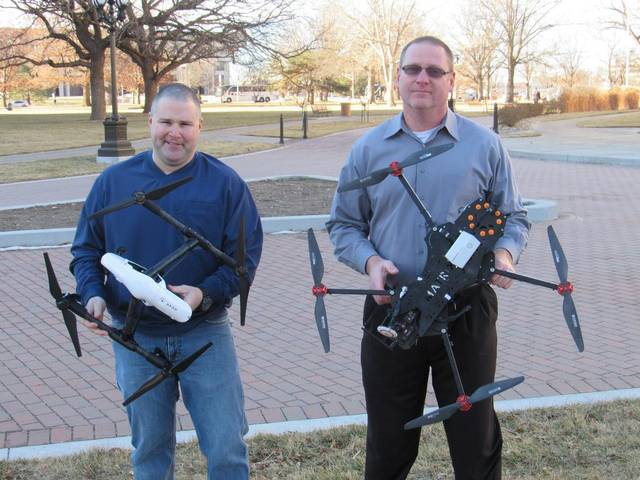Westar Energy will soon deploy drones in the war on power outages. The state’s dominant electric company last week obtained a rule exemption from the Federal Aviation Administration to begin using two remote-controlled aerial drones.
Company officials say that once a few final details are finished, the drones will be able to perform a variety of tasks such as searching out remote transmission line breaks, pinpointing storm damage and inspecting wind turbine blades.
“The abilities with these systems are endless,” said Jason Klenklen, supervisor of transmission maintenance and one of Westar’s two drone-qualified pilots. “You name it, it can be done with them – anything from aerial inspection of wind turbines to shooting pictures for our communications department.”
The two drones Westar is getting approved are quad-copter-style machines about 2 to 3 feet across, including the propellers – similar to what a model airplane enthusiast might buy from a hobby shop. They weigh 5 to 12 pounds, most of which is the batteries, Klenklen said.
But while they’re more or less the same size as hobby drones, they’re not toys. If one gets wrecked, it has to be reported like an actual plane crash.
“It’s not fun and games when you’re doing this stuff,” Klenklen said. “It’s all seriousness when it comes down to flying them.”
One major advantage to drones is they’re inexpensive to buy and maintain compared with crewed aircraft. The drones Westar wants to use cost about $5,000 to $15,000.
Most of the cost isn’t the drone itself but the high-quality sensors and cameras that allow for close and detailed inspection of utility towers and lines without having to put a human in danger, Klenklen said.
“It’s safer for all involved,” Klenklen said.
Take, for example, inspecting a wind turbine blade for damage or defects.
Using a drone can eliminate such unnerving tasks as having to ride up on a 200-foot-tall bucket truck or having a worker in climbing gear rappel down the blade from the hub 200 feet above the ground, Klenklen said.
Westar plans to focus at first on using the drones for emergency line inspections, because they can be deployed faster, which helps restore power quicker than other methods, Klenklen said.
Operators can put the drone in a pickup and take it out to a problem area faster and cheaper than they can prepare and use a helicopter for the task.
Under current FAA regulations, Westar will be able to fly its drones only in remote areas of its service territory. One rule specifies that only those who are part of the technical team – in essence, pilots and observers – can be within 500 feet of the drone when it’s in use.
“Say there was somebody camping under the line or something like that; we cannot fly over them,” Klenklen said.
FAA regulations also require commercial drone pilots to be licensed to also pilot manned aircraft. And the drone always has to be in the line of sight of the operators.
Westar has been working since 2013 with Kansas State and other universities to develop its unmanned aerial program.
The company still has to get some final approvals from the FAA before it can launch. Until then, the drones can’t be flown even inches off the ground except in a drone aviary like the one at K-State-Salina, company officials said.
“We’ve got to go through the registration process and all that, just like a manned aircraft,” Klenklen said. “Some people think it’s kind of silly that we have to jump through those same hoops, but unfortunately, where we are at regulatory-wise, that’s what we have to do.”
The FAA exemption granted last week is the biggest hurdle. Klenklen said he now hopes the rest of the process can be measured in weeks instead of months.
The nation’s major electric utility associations have been urging the FAA to relax the rules and streamline the process for utilities.
“Although this is a step in the right direction, the exemption process is cumbersome, burdensome and overly restrictive,” said an April 24 letter to the FAA from the National Rural Electric Cooperative Association. Co-ops cover about 75 percent of the U.S. landmass.
“Delivering reliable electrical service is a matter of great economic and national security importance, and maintaining electric delivery service and restoring power after an outage is a matter of public health, safety and welfare,” the letter said. “The UAS (Unmanned Aircraft System) platform offers electric cooperatives a powerful new tool for performing this vital mission, as has already been demonstrated in other parts of the world.”
But while using drones for utility operations is slow getting off the ground, the sky’s the limit on what they’ll eventually be able to do, Klenklen said.
“I had a friend send me a video the other day of a drone that will fly and it will go underwater both,” Klenklen said. “The technology is evolving so rapidly that even next week, we’ll probably be surprised what we’re able to do with them.”
Source: The Wichita Eagle

